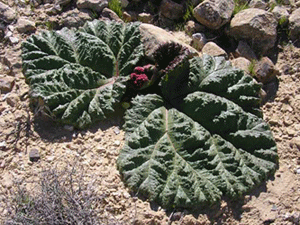 The world’s first "self-watering" plant has been discovered in Israel’s Negev desert – one of the driest regions on earth. The Desert Rhubarb can hold 16 times more water than its rivals and has developed a unique ability to effectively water itself in its barren habitat.
The world’s first "self-watering" plant has been discovered in Israel’s Negev desert – one of the driest regions on earth. The Desert Rhubarb can hold 16 times more water than its rivals and has developed a unique ability to effectively water itself in its barren habitat.Researchers were confounded by the metre-wide plant’s giant leaves, compared to its desert counterparts, whose tiny leaves stop dangerous moisture loss. But they found the plant’s large leaves are the key to its success, because they are covered in microscopic streams through which water can be channelled. Scientists claim ridges in the leaves act like mountain valleys, funnelling the water slowly and directly into the plant while stopping it evaporating.
A team from the University of Haifa-Oranim, in Israel, said the leaves act like a mini irrigation system, the Daily Telegraph reported. "We know of no other plant
in the deserts of the world that functions in this manner," lead researcher Gidi Ne’eman said. "We have managed to make out the "self-irrigating" mechanism of the desert rhubarb, which enables it to harvest 16 times the amount of water than otherwise expected for a plant in this region based on the quantities of rain in the desert", he added.
Results of analysis of the plant’s growth — in an area with an average annual rainfall of 75mm — showed that the desert rhubarb is able to harvest quantities of water that are closer to that of Mediterranean plants, reaching up to 426mm per year.
Source: The Times of India

No comments:
Post a Comment
Please be assured that we are moderating comments for spam, not dissent.
Thank you for sharing your opinion!
NOTE: We will not publish any comments containing hyperlinks that are not directly relevant to the post